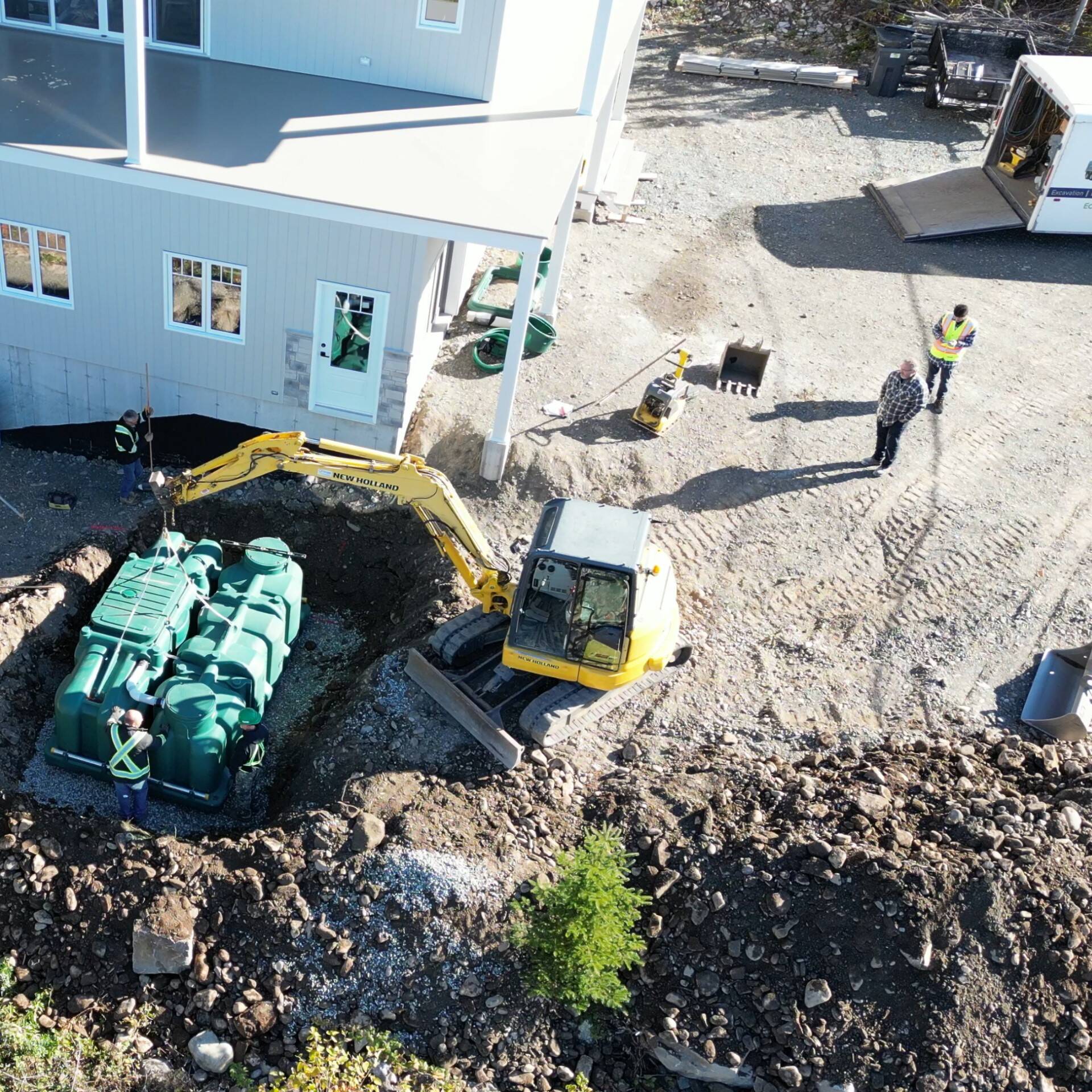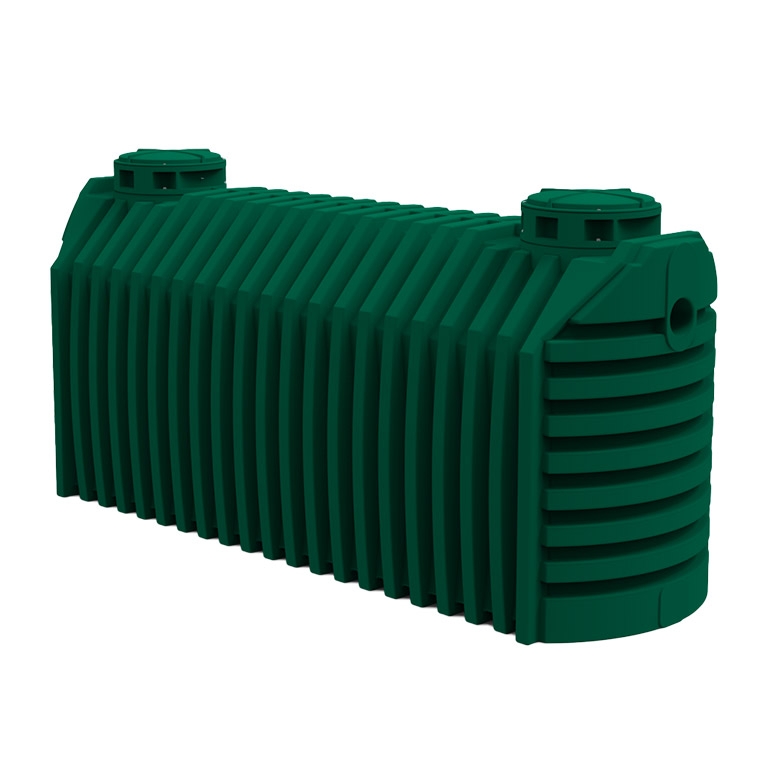Septic holding tanks vs. septic tanks: What’s the difference?

If you are buying a rural property with a holding tank or septic tank, you may think they do pretty much the same thing. They’re both septic systems, right?
Not exactly.
There are six major differences between holding tanks and septic tanks: they have different purposes, appearances, installation costs, pumping schedules, long-term maintenance costs, and permit requirements.
By knowing the ways in which holding tanks differ from septic tanks, you can make an informed decision before you purchase your dream property in the country.
Table of contents
Holding tanks and septic tanks have different purposes
Holding tanks and septic tanks work differently.
Both systems receive your home’s sewage, but holding tanks offer no treatment and have no outlet. They store raw wastewater until a pumper removes it.
Septic tanks provide primary treatment by allowing wastewater to separate into three layers. Scum rises to the top of the tank, solids sink to the bottom, and partially clarified liquids flow through an outlet pipe for further treatment or final dispersal.
Why would a house have a septic holding tank?
A house or cottage would use a holding tank if it had no connection to a municipal sewer and unsuitable conditions for an on-site septic system. Holding tanks may also be used during new constructions before a more permanent sewage system is installed.
Why do some houses have septic tanks?
Houses and cottages use septic tanks if they are not connected to a municipal sewer, and they have suitable space and soil for an on-site septic system. According to Statistics Canada, at least 15% of Canadian households use septic tank systems to treat their wastewater.
Holding tanks and septic tanks look different
It is easy to see the differences between holding tanks and septic tanks when you compare these features:
- number of lids
- number of compartments
- partition walls
- tank outlets
- high-level alarms
What does a septic holding tank look like?
In many cases, residential holding tanks — sometimes known as tight tanks — have one lid and one compartment.
Because a holding tank’s purpose is to store wastewater, it has no partition walls and no outlet.
Inside the unit, a high-level float connects to an alarm that activates when the tank is almost full. This prevents over-filling that could result in a sewage backup that spills into your home or contaminates the environment.
What does a septic tank look like?
Residential septic tanks usually have two lids and two compartments.
Unlike holding tanks, septic tanks also have internal components that allow them to partially clarify your wastewater:
- Inlet baffle
The inlet baffle directs incoming wastewater downward toward the mid-level of the septic tank. This keeps surface scum from clogging the inlet pipe. It also makes it easier for solids to naturally settle on the bottom of the tank.
- Partition wall
Sometimes called a baffle wall, the partition wall separates compartments inside the tank. It helps to keep scum and solids in the first compartment. It also has an opening that allows liquids to flow between compartments.
- Outlet baffle
The outlet baffle draws liquid from the mid-level of the tank and directs it to the outlet pipe. This prevents sludge and scum from leaving the tank and clogging downstream components.
- Effluent filter
The effluent filter is a device in the outlet baffle that can be removed and cleaned. It traps and retains fine particles that would otherwise clog downstream components.
Holding tanks and septic tanks have different installation costs
Holding tanks are cheaper to install than septic tanks.
It all comes down to their designs. Holding tanks are simple storage systems with no outlet. Unlike septic tanks, their designs do not include:
- wastewater treatment components
- piping to a dispersal area
- large amounts of granular materials, such as sand and gravel
- drain field (also known as a leach field) where effluent returns to the site’s soil
How much does it cost to install a septic holding tank?
Total project costs to install a holding tank include several factors. There is the price of the tank, of course, but also designs, permits, materials, and labour.
For example, let’s assume that you have a family of four and that your property is flat and easy to access. Based on local regulations, you choose a concrete holding tank with a capacity of 9,000 L.
In this scenario, the total project cost to install the holding tank would start at approximately $8,000.
Septic tank installation costs
Total project costs to install a septic tank also depend on many factors. The most obvious costs are the septic tank and its drain field. But you also need to plan for the expenses of soil tests, designs, permits, materials, and labour.
As an example, say that you have a four-bedroom home on a property that is flat and easy to access. Based on the regulations in your area, you choose a concrete septic tank with a capacity of 6,000 L.
In this case, the total project cost to install the septic tank and its drain field would likely be between $20,000 and $30,000.
Holding tanks and septic tanks have different pumping schedules
Holding tanks need to be pumped more frequently than septic tanks.
The reason is simple. Holding tanks retain all the sewage that flows into them. Septic tanks retain solids and scum, but they allow liquid wastewater to return to the site’s soil via a drain field.
How often do septic holding tanks need to be pumped?
Holding tanks need to be pumped often to prevent sewage backups in your home and environmental contamination. Depending on the capacity of your tank and the amount of wastewater your household generates, you can expect to need a pump-out every two to four weeks.
How often do you need to pump a septic tank?
In most cases, residential septic tanks are pumped according to schedules laid out in local regulations. According to the Canadian Mortgage and Housing Corporation, it is best to have your tank emptied every three to five years, or when one-third of its volume is filled with solids.
Pumping may be needed more often if you use a garbage disposal for your food scraps.
Holding tanks and septic tanks have different long-term maintenance costs

The prices to empty holding tanks and septic tanks are usually similar. But because holding tanks require pumping every two to four weeks, they have far higher long-term maintenance costs.
These expenses can create a heavy financial burden for some homeowners — so much so that some jurisdictions in Canada discourage or even prohibit the installation of holding tanks.
How much does it cost to pump a septic holding tank?
The cost to pump a holding tank depends on the region where you live, the tank's capacity, and the method of disposal.
In Ontario, a tank that holds 9,000 L costs about 3 cents per litre if your waste goes to a sanitary landfill. The cost increases to about 9 cents per litre if your septic pumper trucks the waste to a municipal treatment plant.
To calculate long-term costs, assume that you own a 9,000 L holding tank and that your sewage is trucked to a municipal treatment plant. At a rate of 9 cents per litre, the final bill for each pump-out would be $810. Even if you need service just once a month, you can expect to pay $9,720 over the course of a year.
How much does it cost to pump a septic tank?
The cost to pump a septic tank depends on the region where you live, the tank's capacity, and the method of disposal.
Again, if we use Ontario as an example, it costs about 3 cents per litre to empty a 6,000 L septic tank when the waste goes to a sanitary landfill. If your septic pumper takes the waste to a municipal treatment plant, the cost is at least 9 cents per litre.
Your pumper may charge additional fees if your tank’s lids are buried and require excavation.
To see these rates in action, imagine that you own a septic tank with a capacity of 6,000 L. Assume that you live near a municipal treatment plant, so the cost of pumping is 9 cents per litre. The total cost to have your septic tank pumped would be $540. If your tank requires a pump-out every three years, the overall cost works out to just $180 per year.
Holding tanks and septic tanks have different permit requirements
In some parts of Canada, getting a permit to install a holding tank is more complex and costlier than getting a permit for a septic tank.
The reason is that holding tanks pose a unique challenge: they threaten the environment if they are not emptied as needed, but the ongoing pumping bills are too expensive for some household budgets.
To prevent environmental contamination, some jurisdictions prohibit holding tanks unless you provide proof of a service contract with a licensed septic pumper.
The permit process for septic tanks is simple by comparison. In many provinces, you can get a permit, often in just a few days, when you provide this information:
- site assessment results, including soil percolation tests
- design plans for your system
- names of the technologies you want to install
- details about the installer

Get the right tank for your property
Need a new septic tank or holding tank? Or still not sure which to choose?
Send us a few quick details and we'll give you free advice and product recommendations based on your needs.






